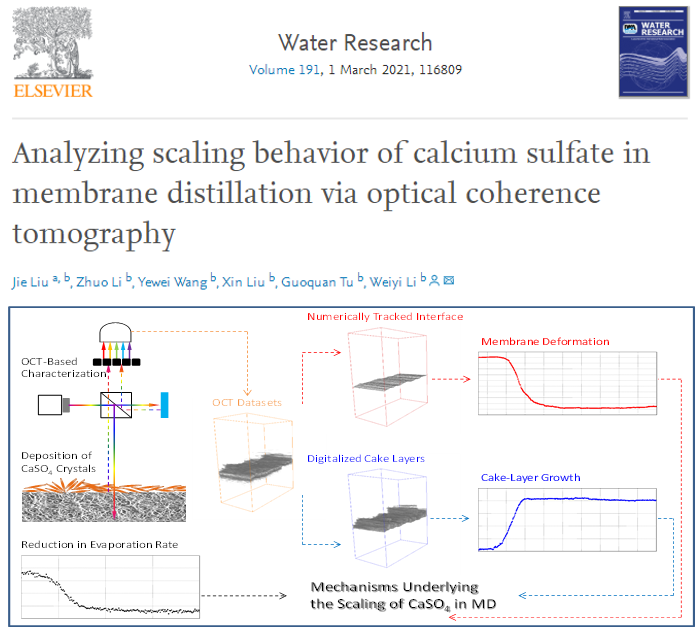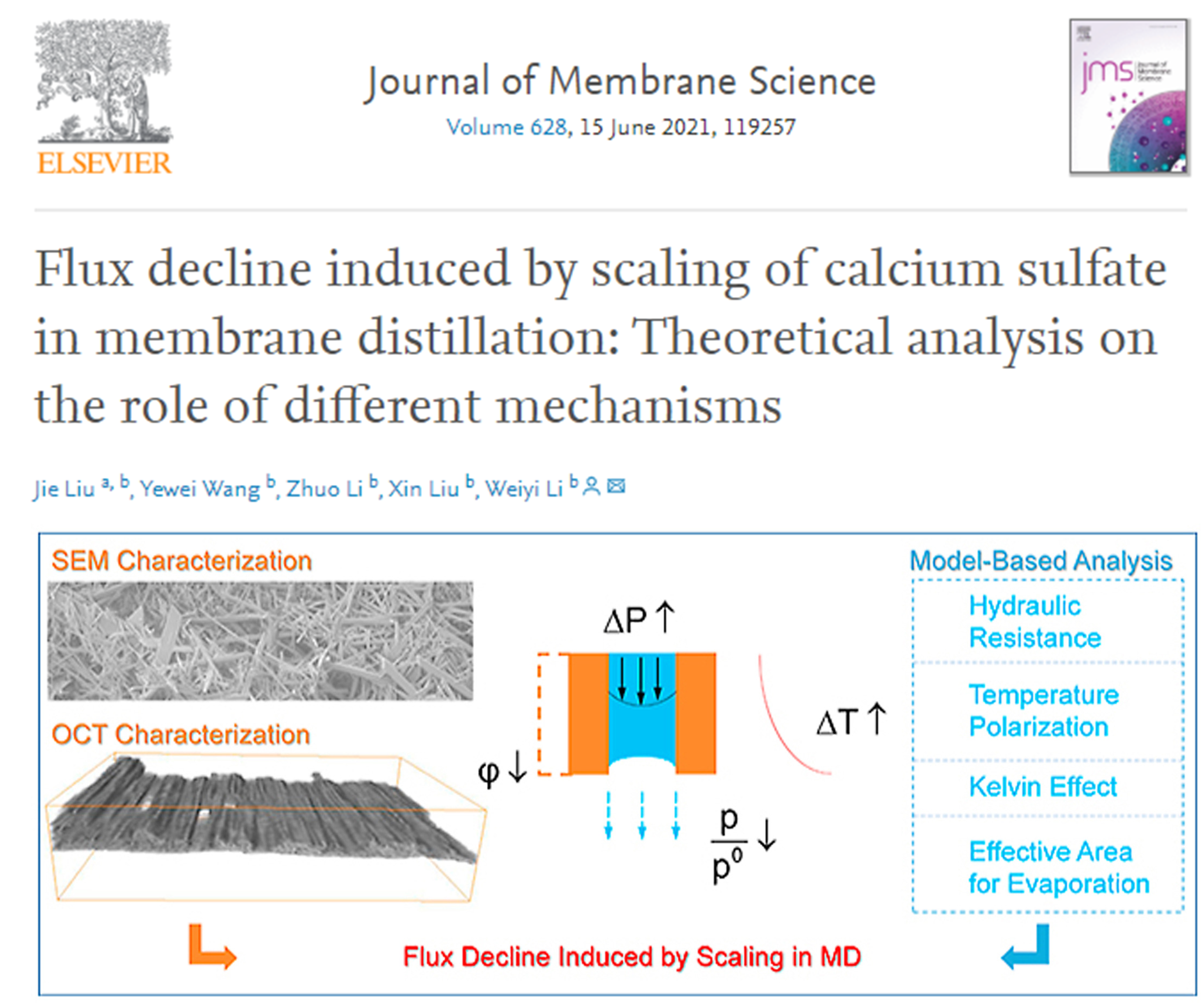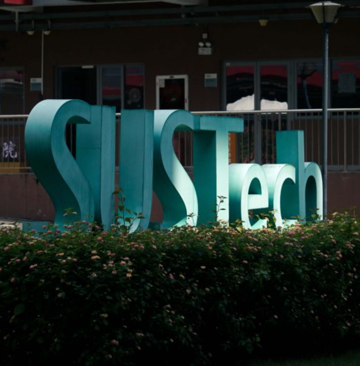SUSTech Weiyi Li's research team explores scaling of calcium sulfate in membrane distillation
Research Associate Professor Weiyi Li of the School of Environmental Sciences and Engineering at the Southern University of Science and Technology (SUSTech) aims at the exploration of novel materials and processes for membrane separations. Prof. Li and his colleagues recently employed optical coherence tomography (OCT) to analyze the scaling behavior of calcium sulfate (CaSO4) in membrane distillation (MD). They developed various methods for quantifying the dynamical effects of scaling and proposed an improved MD model for assessing the effects of the Spatio-temporal evolution of CaSO4 on the flux decline. Their research was published in Water Research and Journal of Membrane Science, which are high-impact journals in the fields of water treatment and membrane separations.

Figure 1. OCT-based in-situ characterization for the scaling of calcium sulfate in membrane distillation
MD is an emerging technique of membrane separations and offers special advantages in the treatment of high salinity brines and brackish waters. However, the advancement of MD is challenged by the scaling of sparingly soluble inorganic salts. In particular, there is a lack of effective methods for tackling the scaling of non-alkaline salts, e.g., CaSO4, primarily owing to the poor understanding of the underlying mechanisms. The occurrence of scaling would not only induce a significant flux decline but also give rise to irreversible damage to the membrane. Providing deeper insights into the scaling behavior in MD entails novel characterization techniques.
OCT is an advanced technique that enables the optical sectioning for the semitransparent medium at micron scales and high scan rates, thereby offering a powerful tool for studying the scaling behavior in MD. This study developed a series of numerical algorithms to interpret the OCT datasets in an effort to resolve the scaling layer with a high resolution. It was for the first time that dissipative structures were revealed during the deposition of the scalants. This work was recently published in Water Research, entitled “Analyzing scaling behavior of calcium sulfate in membrane distillation via optical coherence tomography.”
The scaling-induced deformation was successfully tracked by numerically analyzing the OCT datasets, thereby enhancing the accuracy of digitalizing the scaling layer. The digitalized scaling layer was exploited to estimate the surface coverage, the specific deposit, and the average cake thickness as a function of time. The growth and deposition of the CaSO4 were then analyzed in association with conventional characterization (including the measurement of vapor flux and conductivity over time). What stands out is that periodic patterns were unraveled by mapping the distribution of the local deposition rate. It indicates that secondary flows were induced by the complex coupling of the heat and mass transfer in the boundary layer.

Figure 2. Schematic demonstrating the analysis of the CaSO4 scaling in MD via OCT (graphical abstract in WR)
OCT offers a straightforward way to explore the scaling behavior of CaSO4 in MD, thereby providing more fundamental information for establishing the underlying mechanisms. It was therefore motivated to improve the classical MD model, which was incorporated with various characterization approaches to assess the relative importance of different mechanisms accounting for the flux decline in MD. This work was recently published in the Journal of Membrane Science, entitled “Flux decline induced by scaling of calcium sulfate in membrane distillation: Theoretical analysis on the role of different mechanisms.”
This study highlighted the nonlinear effects of the mass and heat transfer while accounting for the presence of a scaling layer and a hydrophilic support layer. The geometrical characteristics of the scaling layer were correlated by the model to offer a tool for simulating the interplay between the scaling-layer growth and the vapor flux through the MD membrane. The modeling results were compared with the characterization results to evaluate the roles of temperature polarization, hydraulic resistance, and various interfacial effects in the scaling-induced flux decline. The comparison supports the hypothesis that the vapor depression should be dominated by the interfacial solidification resulting from the growth of CaSO4 crystals.

Figure 3. Schematic of analyzing the scaling-induced flux decline by combining characterization and modeling (graphical abstract in JMS)
All the studies shed light on the formation and evolution of a scaling layer in MD, whereby the MD-based applications would be improved to inject impetus into sustainable development.
Jie Liu, a Ph.D. student supported by the joint doctoral program between SUSTech and HIT, is the first author of both papers. Dr. Weiyi Li, a Research Associate Professor at SUSTech, is the corresponding author of both papers. This work was supported by the National Natural Science Foundation of China (NSFC), Program for Guangdong Introducing Innovative and Entrepreneurial Teams, Shenzhen Science, Technology and Innovation Commission (SZSTI), and the Department of Education of Guangdong Province.
Paper link in Water Research: https://doi.org/10.1016/j.watres.2021.116809
Paper link in Journal of Membrane Science: https://doi.org/10.1016/j.memsci.2021.119257
